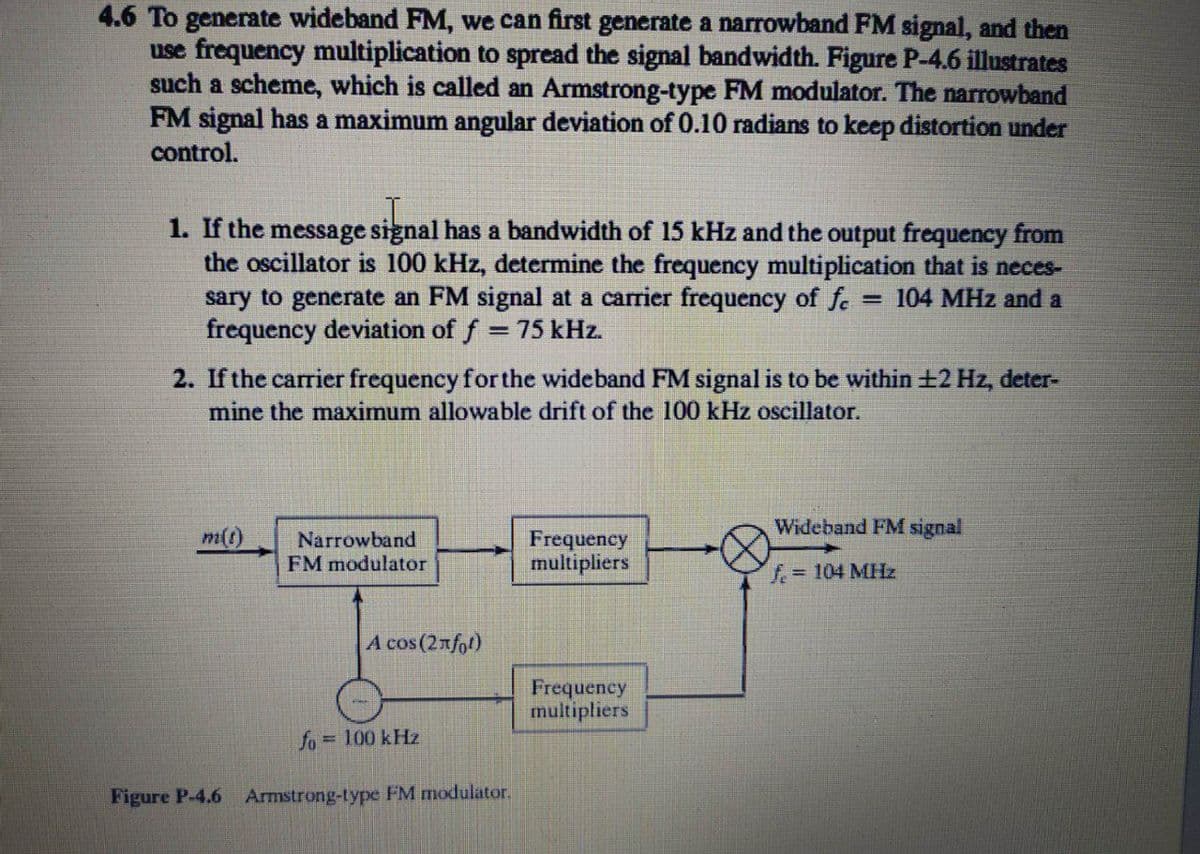4.6 To generate wideband FM, we can first generate a narrowband FM signal, and then use frequency multiplication to spread the signal bandwidth. Figure P-4.6 illustrates such a scheme, which is called an Armstrong-type FM modulator. The narrowband FM signal has a maximum angular deviation of 0.10 radians to keep distortion under control. 1. If the message signal has a bandwidth of 15 kHz and the output frequency from the oscillator is 100 kHz, determine the frequency multiplication that is neces- sary to generate an FM signal at a carrier frequency of fe frequency deviation of f = 75 kHz. = 104 MHz and a
4.6 To generate wideband FM, we can first generate a narrowband FM signal, and then use frequency multiplication to spread the signal bandwidth. Figure P-4.6 illustrates such a scheme, which is called an Armstrong-type FM modulator. The narrowband FM signal has a maximum angular deviation of 0.10 radians to keep distortion under control. 1. If the message signal has a bandwidth of 15 kHz and the output frequency from the oscillator is 100 kHz, determine the frequency multiplication that is neces- sary to generate an FM signal at a carrier frequency of fe frequency deviation of f = 75 kHz. = 104 MHz and a
Introductory Circuit Analysis (13th Edition)
13th Edition
ISBN:9780133923605
Author:Robert L. Boylestad
Publisher:Robert L. Boylestad
Chapter1: Introduction
Section: Chapter Questions
Problem 1P: Visit your local library (at school or home) and describe the extent to which it provides literature...
Related questions
Concept explainers
KVL and KCL
KVL stands for Kirchhoff voltage law. KVL states that the total voltage drops around the loop in any closed electric circuit is equal to the sum of total voltage drop in the same closed loop.
Sign Convention
Science and technology incorporate some ideas and techniques of their own to understand a system skilfully and easily. These techniques are called conventions. For example: Sign conventions of mirrors are used to understand the phenomenon of reflection and refraction in an easier way.
Question
None

Transcribed Image Text:4.6 To generate wideband FM, we can first generate a narrowband FM signal, and then
use frequency multiplication to spread the signal bandwidth. Figure P-4.6 illustrates
such a scheme, which is called an Armstrong-type FM modulator. The narrowband
FM signal has a maximum angular deviation of 0.10 radians to keep distortion under
control.
1. If the message signal has a bandwidth of 15 kHz and the output frequency from
the oscillator is 100 kHz, determine the frequency multiplication that is neces-
sary to generate an FM signal at a carrier frequency of fe
frequency deviation of f = 75 kHz.
=104 MHz and a
%3D
2. If the carrier frequency for the wideband FM signal is to be within +2 Hz, deter-
mine the maximum allowable drift of the 100 kHz oscillator.
Wideband FM signal
m(t)
Narrowband
FM modulator
Frequency
multipliers
f=D104 MHz
A cos (2nfot)
Frequency
multipliers
fo= 100 kHz
Figure P-4.6 Armstrong-type FM modulator.
Expert Solution
This question has been solved!
Explore an expertly crafted, step-by-step solution for a thorough understanding of key concepts.
This is a popular solution!
Trending now
This is a popular solution!
Step by step
Solved in 2 steps with 1 images

Knowledge Booster
Learn more about
Need a deep-dive on the concept behind this application? Look no further. Learn more about this topic, electrical-engineering and related others by exploring similar questions and additional content below.Recommended textbooks for you

Introductory Circuit Analysis (13th Edition)
Electrical Engineering
ISBN:
9780133923605
Author:
Robert L. Boylestad
Publisher:
PEARSON

Delmar's Standard Textbook Of Electricity
Electrical Engineering
ISBN:
9781337900348
Author:
Stephen L. Herman
Publisher:
Cengage Learning

Programmable Logic Controllers
Electrical Engineering
ISBN:
9780073373843
Author:
Frank D. Petruzella
Publisher:
McGraw-Hill Education

Introductory Circuit Analysis (13th Edition)
Electrical Engineering
ISBN:
9780133923605
Author:
Robert L. Boylestad
Publisher:
PEARSON

Delmar's Standard Textbook Of Electricity
Electrical Engineering
ISBN:
9781337900348
Author:
Stephen L. Herman
Publisher:
Cengage Learning

Programmable Logic Controllers
Electrical Engineering
ISBN:
9780073373843
Author:
Frank D. Petruzella
Publisher:
McGraw-Hill Education

Fundamentals of Electric Circuits
Electrical Engineering
ISBN:
9780078028229
Author:
Charles K Alexander, Matthew Sadiku
Publisher:
McGraw-Hill Education

Electric Circuits. (11th Edition)
Electrical Engineering
ISBN:
9780134746968
Author:
James W. Nilsson, Susan Riedel
Publisher:
PEARSON

Engineering Electromagnetics
Electrical Engineering
ISBN:
9780078028151
Author:
Hayt, William H. (william Hart), Jr, BUCK, John A.
Publisher:
Mcgraw-hill Education,